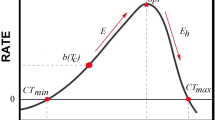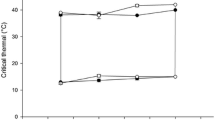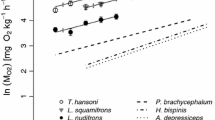Abstract
Although acutely measured rate processes in coelenterates show close correlation with the Van't Hoff Q10 rule and the distribution of many coelenterate groups is correlated with temperature, little is known about coelenterate temperature adaptation. Analysis of lethal temperatures shows that the southern distribution of 3 species of North Atlantic actinians is correlated with their upper lethal temperature. Oxygen consumption data from acute measurements indicate conformity to the Q10 rule. Oxygen consumption data from animals pre-exposed to various temperatures indicate that oxygen consumption is capable of acclimation to temperature. Metridium senile from Massachusetts shows positive acclimation, typical of a poikilotherm partially regulating its metabolic rate in response to temperature change. Two species from Virginia, Haliplanella luciae and Diadumene leucolena, appear to show a reverse pattern. Their response includes encystment and negative adjustment of metabolic rate, showing evasion rather than regulation in response to environmental change. Temperature has a marked effect on parameters of the activity pattern of Diadumene leucolena, but the temperature sensitivity of activity is not correlated with that of oxygen consumption.
Similar content being viewed by others
Literature cited
Allee, W. C.: Studies in marine ecology: IV. The effect of temperature in limiting the geographical range of invertebrates of the Woods Hole littoral. Ecology 4, 341–354 (1923).
Batham, E. J. and C. F. A. Pantin: Inherent activity in the sea-anemone, Metridium senile (L.) J. exp. Biol. 27, 290–301 (1950a).
— Phases of activity in the sea-anemone, Metridium senile (L.), and their relation to external stimuli. J. exp. Biol. 27, 377–399 (1950b).
— Muscular and hydrostatic action in the sea-anemone Metridium senile (L.). J. exp. Biol. 27, 264–289 (1950c).
Cargo, D. C. and L. P. Schultz: Further observations on the biology of the sea nettle and jellyfishes in Chesapeake Bay. Chesapeake Sci. 4, 209–220 (1967).
Coast and Geodetic Survey: Surface water temperature and salinity Atlantic Coast North and South America. C. & G.S. Publication 31-1, 76 pp. Washington: Government Printing Office 1960.
Cones, H. N., Jr. and D. S. Haven: Distribution of Chrysaora quinquecirrha in the York River. Chesapeake Sci. 10, 75–84 (1969).
Crowell, S.: Differential responses of growth zones to nutritive level, age, and temperature in the colonial hydroid Campanularia. J. exp. Zool. 134, 63–90 (1957).
— and M. Rusk: Growth of Campanularia colonies. Biol. Bull. mar. biol. Lab., Woods Hole 99, 357 (1950).
Field, L.: Sea anemones and corals of Beaufort, N.C. Bull. Duke Univ. mar. Stn 5, 1–39 (1949).
Gwilliam, G. F.: Neuromuscular physiology of a sessile seyphozoan. Biol. Bull. mar. biol. Lab., Woods Hole 119, 454–473 (1960).
Hall, D. M. and C. F. A. Pantin: The nerve net of the actinozoa V. Temperature and facilitation in Metridium senile. J. exp. Biol. 14, 71–78 (1937).
Hand, C.: The sea anemones of Central California. III. The acontiarian anemones. Wasmann J. Biol. 13, 189–251 (1955).
Harvey, E. N.: The effect of different temperatures on the medusa Cassiopea, with special reference to the rate of conduction of the nerve impulse. Pap. Tortugas Lab. 3, 27–39 (1911).
Hoffmann, R. J. and C. P. Mangum: The function of coelomic cell hemoglobin in the polychaete Glycera dibranchiata. Comp. Biochem. Physiol. (In press).
Lenhoff, H. M. and W. F. Loomis: Environmental factors controlling respiration in Hydra. J. exp. Zool. 134, 171–181 (1957).
Mangum, C. P. and C. Sassaman: Temperature sensitivity of active and resting metabolism in a polychaetous annelid. Comp. Biochem. Physiol. 30, 111–116 (1969).
Mayor, A. G.: Ctenophores of the Atlantic Coast of North America. Publs Carnegie Instn 162, 1–58 (1912).
— The effects of temperature upon tropical marine animals. Pap. Tortugas Lab. 6, 1–24 (1914).
McCary, A.: The effect of temperature on growth and reproduction in Craspedacusta sowerbi. Ecology 40, 158–162 (1959).
McClendon, J. F.: The direct and indirect calorimetry of Cassiopea xamachana. J. biol. Chem. 32, 275–296 (1917).
Newell, R. C. and H. R. Nobthcroft: A re-interpretation of the effect of temperature on the metabolism of certain marine invertebrates. J. Zool., Lond. 151, 277–298 (1967).
Pantin, C. F. A. and M. Vianna Dias: Excitation phenomena in an actinian (Bunodactis sp?) from Guanabara Bay. Anais Acad. bras. Cienc. 24, 335–349 (1952).
Parker, G. H.: The effects of the past winter on the occurrence of Sagartia luciae Verrill. Am. Nat. 53, 280–281 (1919).
— Activities of colonial animals II. Neuromuscular movements and phosphorescence of Renilla. J. exp. Zool. 31, 475–515 (1920).
Pieron, H.: De l'influence de l'oxygene dissous sur le comportement des invertebres marins. II. Quelque moyens de défense contre l'asphyxie. C.r. Séanc. Soc. Biol. 64, 955–957 (1908).
Prosser, C. L. and F. A. Brown, Jr.: Comparative animal physiology, 688 pp. Philadelphia: Saunders 1961.
Roberts, J. L.: Thermal acclimation of metabolism in the crab, Pachygrapsus crassipes Randall. II. Mechanisms and the influence of season and latitude. Physiol. Zoöl. 30, 242–255 (1957).
Sellers, R. and J. L. Roberts: The influence of temperature and photoperiod on rhythmic potentials and growth in Hydra pseudoligactis. Am. Zool. 4, 55 (1964).
Shoup, C. S.: Salinity of the medium and its effect on respiration in the sea-anemone. Ecology 13, 81–85 (1932).
Tribe, M. A. and K. Bowler: Temperature dependence of “standard metabolic rate” in a poikilotherm. Comp. Biochem. Physiol. 25, 427–436 (1968).
Vernon, H. M.: The respiratory exchange of the lower marine invertebrates. J. Physiol., Lond. 19, 18–70 (1895).
Wass, M. L.: Check list of the marine invertebrates of Virginia. Va. Inst. mar. Sci. Rep. No. 24 (3rd revision) 55 pp. (1965).
Weese, A. O., and M. T. Townsend: Some reactions of the jellyfish Aequoria. Publs Puget Sound mar. biol. Stn 3, 117–128 (1921).
Wolf, E.: Temperature characteristics for pulsation in Gonionemus. J. gen. Physiol. 11, 547–562 (1928).
Author information
Authors and Affiliations
Additional information
Communicated by G. L. Voss, Miami
Rights and permissions
About this article
Cite this article
Sassaman, C., Mangum, C.P. Patterns of temperature adaptation in North American Atlantic coastal actinians. Marine Biology 7, 123–130 (1970). https://doi.org/10.1007/BF00354915
Accepted:
Issue Date:
DOI: https://doi.org/10.1007/BF00354915




